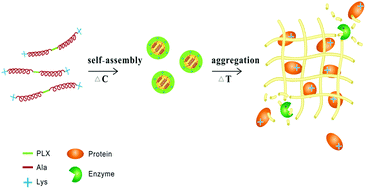A poloxamer-polypeptide thermosensitive hydrogel as a cell scaffold and sustained release depot
Abstract
Herein, we report the synthesis and characterization of a novel positively charged thermosensitive hydrogel prepared from poloxamer (PLX)-poly(L-alanine-lysine) (Lys-Ala-PLX-Ala-Lys) that demonstrates potential in biomedical applications including tissue engineering and drug delivery. At a dilute concentration, the copolymer self-assembled into micelles that were sensitive to temperature elevation. In the concentration range of 3–7 wt%, the aqueous copolymer solution underwent sol–gel transition near the physiological temperature and exhibited changes in its secondary structure content, as evidenced by FT-IR. Excellent viability of cells cultured within the scaffold was observed after 72 h of incubation. On the other hand, negatively charged bovine serum albumin was incorporated into the hydrogel without diminishing material integrity. Over the course of seven days, the protein underwent extended zero-order release. These findings highlight the potential of this system as a cell scaffold as well as a depot for the extended delivery of drugs and proteins, specifically those which bear a charge opposite to that of the hydrogel.


 Please wait while we load your content...
Please wait while we load your content...